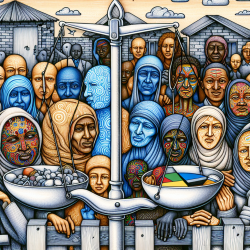Introduction
Atopic dermatitis (AD) is a prevalent inflammatory skin condition characterized by eczematous lesions and intense itching, leading to significant morbidity and quality of life impairment. Recent research highlights that individuals with skin of color (SOC), particularly those in displaced populations, bear a disproportionate burden of this disease. The study titled "The Impact of Global Health Disparities on Atopic Dermatitis in Displaced Populations: Narrowing the Health Equity Gap for Patients with Skin of Color" sheds light on these disparities and suggests strategies for practitioners to address them.
Understanding the Disparities
Displaced populations, including refugees, migrants, and asylum seekers, face unique challenges that exacerbate their susceptibility to AD. Factors such as poor living conditions, climate change, psychological stress, and limited access to healthcare contribute significantly to the disease burden. These conditions are often compounded by structural, environmental, and interpersonal racism, particularly in the USA.
Implementing Research Outcomes
Practitioners can enhance their approach to managing AD in displaced populations by integrating the following strategies derived from the research:
- Improving Living Conditions: Advocate for better housing conditions in refugee camps and resettlement communities to reduce exposure to allergens and irritants that exacerbate AD.
- Addressing Climate Change: Recognize the impact of climate change on AD and support initiatives that mitigate its effects, particularly in urban areas where displaced populations are concentrated.
- Managing Psychological Stress: Incorporate stress management techniques into treatment plans for AD, acknowledging the role of trauma and stress in exacerbating symptoms.
- Enhancing Access to Care: Work towards eliminating barriers to healthcare for displaced populations by providing culturally competent care and advocating for policy changes that ensure equitable access to dermatologic services.
Encouraging Further Research
While existing research provides valuable insights, there is a need for further studies to better understand the prevalence and management of AD in displaced populations. Practitioners are encouraged to contribute to this body of knowledge by participating in research initiatives and collaborating with interdisciplinary teams to develop comprehensive care models that address the unique needs of these communities.
Conclusion
Addressing the health disparities faced by displaced populations with atopic dermatitis requires a multifaceted approach that includes improving living conditions, mitigating the effects of climate change, managing psychological stress, and enhancing access to care. By implementing these strategies, practitioners can play a crucial role in narrowing the health equity gap for patients with skin of color.
To read the original research paper, please follow this link: The Impact of Global Health Disparities on Atopic Dermatitis in Displaced Populations: Narrowing the Health Equity Gap for Patients with Skin of Color.










